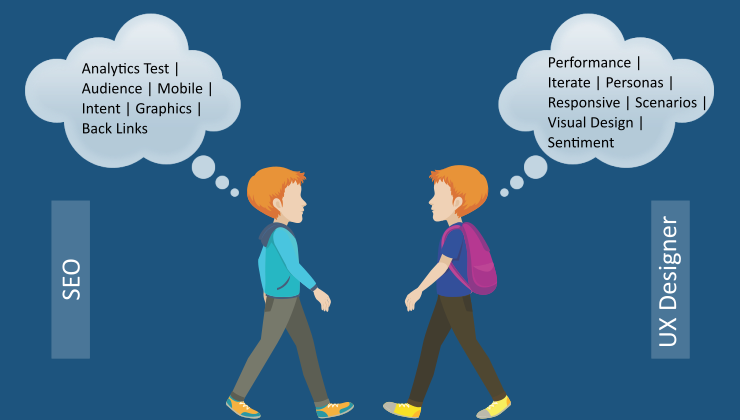Most of us have this misconception that Search Engine Optimization (SEO) and User Experience (UX) are at odds with each other but in reality, they are far better off together than apart. A website becomes a traffic puller only after the search engine validates it as a hit. And this can be done by simply optimizing the site right according to the needs and interests of the end user and centering their concerns. Over the recent years, expectations of consumers have dramatically changed to a great extent. Earlier nobody knew what they wanted or what to expect but tables have completely turned these days, customers have become smarter and wiser. In addition to this, search engines have succeeded in adapting how they interpret and often end up displaying information based on the modification of user intent. End users always have certain expectations when they interact with a brand in particular.
Hence, it becomes very important for businesses to combine user experience design (UX) and search engine optimization (SEO) strategies to drive business effectively.
But The Question Is How?
We all are well aware regarding the fact that Google is taking charge of how we use the internet by making significant changes to its search engine optimization algorithms and protocols. And as a result, SEO is reshaping the way we live our lives as well as the organic landscape of business. SEO and UX share a few goals in common and they are:
Irrespective of your industry, a website requires to build an adequate amount of trust, answer questions, provide services, and sell products.
It’s all about creating a holistic online presence to drive qualified traffic and increase conversions on your website. Which means that one needs to maximize their search engine visibility while optimizing the website.
Customers always tend to turn to search engines to find answers and once they find a website that meets their needs, they do expect a great experience.
How is UX design + SEO equal to chocolate and peanut butter?
SEO mainly focuses on external elements and the overall architecture of the website. Which ultimately results in driving traffic to your website. While on the other hand, UX primarily focuses on engaging customers by implementing a design that minimizes distraction and maximizes conversions.
“Driving traffic to any site is worthless until and unless the site is not qualified. Similarly, designing your website is useless if you don’t have any traffic to convert.”
In the Earlier years, SEOs and UX designers were once competing against each other. Each of them thought that their craft was better due to which many software development companies ended up dividing between departments. As the digital transformation took place worldwide, online marketing becomes more user-focused and companies have realized the fact that SEO and UX work together to drive more sales.
One of the simplest ways to raise your UX ranking is to make your website load on the quick basis. This can be done by simply writing quality code or using the image compression and optimization, running the page from high-end servers, etc. With the help of tools like Google’s page speed insights, one can easily measure success.
Next, one needs to understand how ideal does the audience thinks? Most of the UX designers believe in creating light content with heavy context. Which means the content on your website has to answer questions and must carry some kind of relevant information that your audience did or wants to ask.
SEO professional must understand that micro-formatting is a part of their job. Micro-formatting basically tells search engines that what your content means in order to rank better.
One can even think of using Google Analytics to discover the UX challenge. All the metrics will definitely provide some help in making the user experience better.
Always follow the five-second rule. For example, if you get sold on your page right in five seconds, your user will definitely will. Using this rule, in particular, will optimize website conversion and result by improving online ROI.
“SEO Finds Your Customers While UX Keeps Them Interested.”
How they both affect each other?
SEO has the data that UX teams need to produce personalized experiences for the end users. While on the other hand, UX teams have the website framework and content optimization insight SEOs need to make crucial decisions to ensure rankings in SERPs. Like I said before, when SEO and UX teams share their findings, they can create optimized experiences for their users.
Now search engines make use of algorithms to identify patterns in how people search and what are they looking for online. The entire process is all about identifying, publishing, and optimizing content that will attract qualified readers. Because once you know what your target audience is looking for, it becomes quite easy to make adjustments to your website accordingly.
Apart from this, it may quite interest you to know that UX design not only influences how an individual perceives a website but it can also impact on how search engines view your website’s authority, relevance, and trust. Website navigation is another way to attract end users.
Conclusion
As search engines, customers and other technologies continue to evolve, it becomes very important for your business to look eye-catching and engaging. On and all, combining your SEO and UX efforts into a valuable strategy will benefit you as well as your customers to a great extent.
